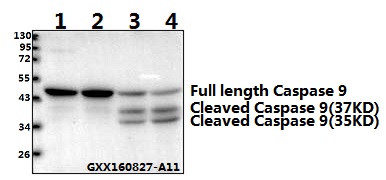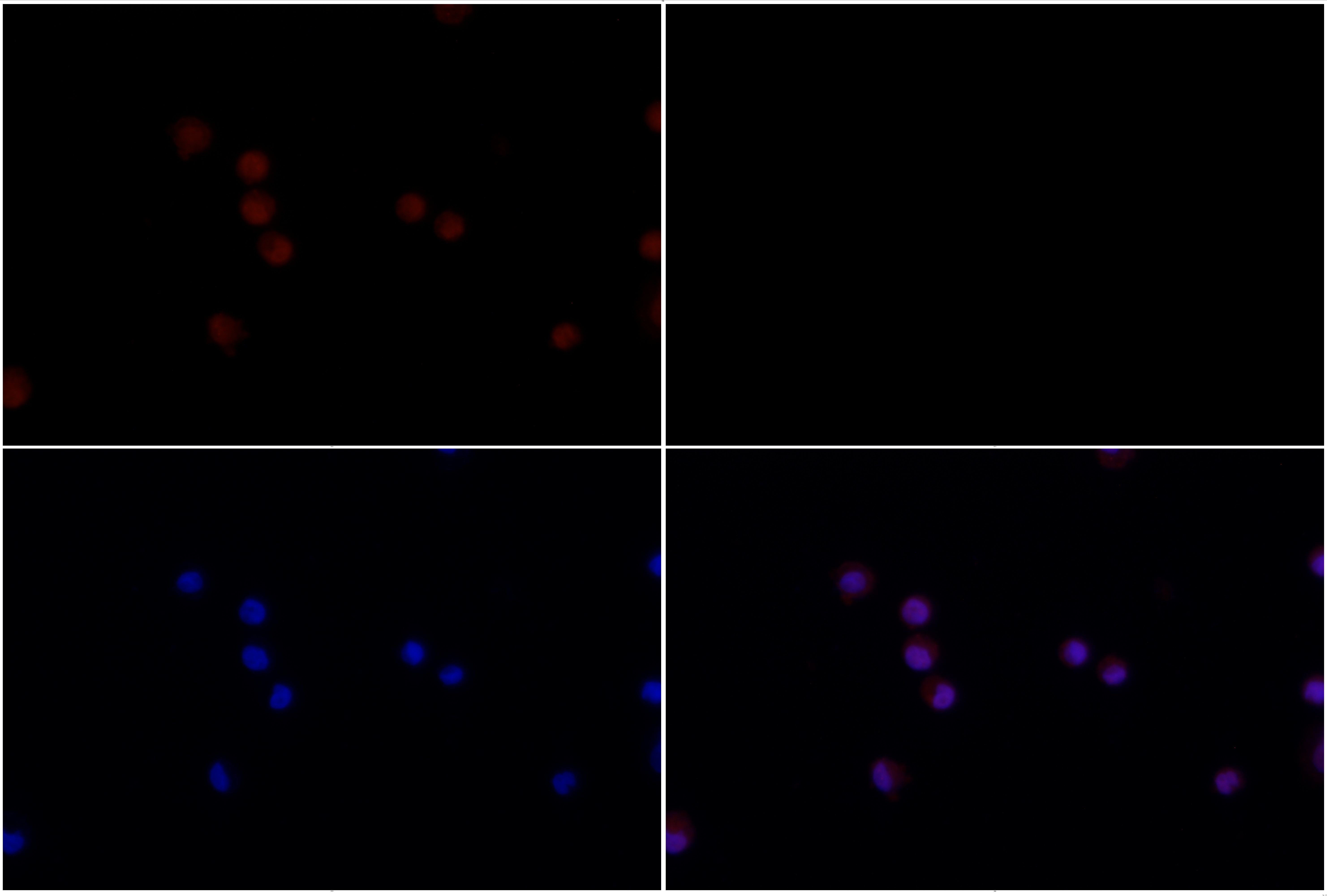Product Name :
Caspase 9 (Tyr153) polyclonal antibody Background :
Caspase 9 (also known as ICE like apoptotic protease 6 (ICE LAP6), apoptotic protease Mch6, and apoptotic protease activating factor 3 (Apaf3)) is a member of the peptidase family C14 that contains a CARD domain. This caspase is active as a heterotetramer and has been reported to have two isoforms. ProCaspase 9 has been reported to be approximately 47 kD. This caspase is present in the cytosol and, upon activation, translocates to the mitochondria. Caspase 9 is involved in the caspase activation cascade responsible for apoptosis execution and cleaves/activates Caspase 3 and Caspase 6. Product :
Rabbit IgG, 1mg/ml in PBS with 0.02% sodium azide, 50% glycerol, pH7.2 Storage&Stability :
Store at 4°C short term. Aliquot and store at -20°C long term. Avoid freeze-thaw cycles. Specificity :
Caspase 9 (Tyr153) polyclonal antibody detects endogenous levels of full length caspase-9 (48 kDa) and large fragments of caspase-9 (35 kDa and 37kDa). Immunogen :
Synthetic peptide, corresponding to amino acids 130-180 of Human Caspase 9. Conjugate :
Unconjugated Modification :
Unmodified
Caspase 9 (Tyr153) polyclonal antibody Background :
Caspase 9 (also known as ICE like apoptotic protease 6 (ICE LAP6), apoptotic protease Mch6, and apoptotic protease activating factor 3 (Apaf3)) is a member of the peptidase family C14 that contains a CARD domain. This caspase is active as a heterotetramer and has been reported to have two isoforms. ProCaspase 9 has been reported to be approximately 47 kD. This caspase is present in the cytosol and, upon activation, translocates to the mitochondria. Caspase 9 is involved in the caspase activation cascade responsible for apoptosis execution and cleaves/activates Caspase 3 and Caspase 6. Product :
Rabbit IgG, 1mg/ml in PBS with 0.02% sodium azide, 50% glycerol, pH7.2 Storage&Stability :
Store at 4°C short term. Aliquot and store at -20°C long term. Avoid freeze-thaw cycles. Specificity :
Caspase 9 (Tyr153) polyclonal antibody detects endogenous levels of full length caspase-9 (48 kDa) and large fragments of caspase-9 (35 kDa and 37kDa). Immunogen :
Synthetic peptide, corresponding to amino acids 130-180 of Human Caspase 9. Conjugate :
Unconjugated Modification :
Unmodified
-
 Western blot (WB) analysis of Caspase 9 (Tyr153) polyclonal antibody at 1:500 dilution Lane1:LO2 whole cell lysate(40ug) Lane2:L02 treated with PBS(1×PBS,PH7.4) for 30 minutes whole cell lysate(40ug) Lane3:L02 treated with PBS(1×PBS,PH7.4) for 120 minutes whole cell lysate(40ug) Lane4:L02 treated with PBS(1×PBS,PH7.4) for 240 minutes whole cell lysate(40ug)
Western blot (WB) analysis of Caspase 9 (Tyr153) polyclonal antibody at 1:500 dilution Lane1:LO2 whole cell lysate(40ug) Lane2:L02 treated with PBS(1×PBS,PH7.4) for 30 minutes whole cell lysate(40ug) Lane3:L02 treated with PBS(1×PBS,PH7.4) for 120 minutes whole cell lysate(40ug) Lane4:L02 treated with PBS(1×PBS,PH7.4) for 240 minutes whole cell lysate(40ug) -

Multisite mutation of monomer survivin with enhanced effect on apoptosis regulation of breast cancer cells
PMCID: Pubmed No.:25661346
Design, synthesis and in vitro evaluation of novel ursolic acid derivatives as potential anticancer agents
PMCID: Pubmed No.:25841199
Synthesis and pharmacological evaluation of dehydroabietic acid thiourea derivatives containing bisphosphonate moiety as an inducer of apoptosis
PMCID: Pubmed No.:26706349
Gambogenic acid mediated apoptosis through the mitochondrial oxidative stress and inactivation of Akt signaling pathway in human nasopharyngeal carcinoma CNE-1 cells
PMCID: Pubmed No.:21118682
PEG-liposomal oxaliplatin induces apoptosis in hunman colorectal cancer cells via Fas/FasL and caspase-8.
PMCID: Pubmed No.:21888623
Cucurmosin induces apoptosis of BxPC-3 human pancreatic cancer cells via inactivation of the EGFR signaling pathway.
PMCID: Pubmed No.:22139427
Down regulation of differentiated embryonic chondrocytes 1 (DEC1) is involved in 8-methoxypsoralen-induced apoptosis in HepG2 cells
PMCID: Pubmed No.:22796345
NG, a novel PABA/NO-based oleanolic acid derivative, induces human hepatoma cell apoptosis via a ROS/MAPK- dependent mitochondrial pathway
PMCID: Pubmed No.:22824464
Poloxamer-188 Attenuates TBI-Induced Blood–Brain Barrier Damage Leading to Decreased Brain Edema and Reduced Cellular Death
PMCID: Pubmed No.:23011204
Methyl methanesulfonate induces apoptosis in p53-deficient H1299 and Hep3B cells through a Caspase 2- and mitochondria -associated pathway
PMCID: Pubmed No.:23117069
Salinomycin induces apoptosis in cisplatin-resistant colorectal cancer cells by accumulation of reactive oxygen species
PMCID: Pubmed No.:23916687
Norisoboldine induces apoptosis of fibroblast-like synoviocytes from adjuvant-induced arthritis rats
PMCID: Pubmed No.:24613208
NG as a novel nitric oxide donor induces apoptosis by increasing reactive oxygen species and inhibiting mitochondrial function in MGC803 cells
PMCID: Pubmed No.:25135879
Curdione Inhibits Proliferation of MCF-7 Cells by Inducing Apoptosis
PMCID: Pubmed No.:25520141
Foxc2 enhances proliferation and inhibits apoptosis through activating Akt/mTORC1 signaling pathway in mice pre-adipocyte
PMCID: Pubmed No.:26113535
Inhibitory effect of epirubicin-loaded lipid microbubbles with conjugated anti-ABCG2 antibody combined with therapeutic ultrasound on multiple myeloma cancer stem cells.
PMCID: Pubmed No.:26204324
Gambogic acid enhances the radiosensitivity of human esophageal cancer cells by inducing reactive oxygen species via targeting Akt/mTOR pathway
PMCID: Pubmed No.:26318432
High glucose concentration induces endothelial cell proliferation by regulating cyclin‐D2‐related miR‐98
PMCID: Pubmed No.:26840039
NG as a novel nitric oxide donor induces apoptosis by increasing reactive oxygen species and inhibiting mitochondrial function in MGC803 cells
PMCID: Pubmed No.:25135879
Curdione Inhibits Proliferation of MCF-7 Cells by Inducing Apoptosis
PMCID: Pubmed No.:25520141
High glucose concentration induces endothelial cell proliferation by regulating cyclin‐D2‐related miR‐98
PMCID: Pubmed No.:26840039
Norisoboldine induces apoptosis of fibroblast-like synoviocytes from adjuvant-induced arthritis rats
PMCID: Pubmed No.:24613208
Triethylenetetramine Synergizes with Pharmacologic Ascorbic Acid in Hydrogen Peroxide Mediated Selective Toxicity to Breast Cancer Cell
PMCID: Pubmed No.:28280522
Enhancing the anti-multiple myeloma efficiency in a cancer stem cell xenograft model by conjugating the ABCG4 antibody with microbubbles for a targeted delivery of ultrasound mediated epirubicin
PMCID: Pubmed No.:28232025
Intramuscular Delivery of scAAV9-hIGF1 Prolongs Survival in the hSOD1 G93A ALS Mouse Model via Upregulation of D-Amino Acid Oxidase
PMCID: Pubmed No.:27995572
High glucose concentration induces endothelial cell proliferation by regulating cyclin‐D2‐related miR‐98
PMCID: Pubmed No.:26840039
Foxc2 enhances proliferation and inhibits apoptosis through activating Akt/mTORC1 signaling pathway in mouse preadipocytes
PMCID: Pubmed No.:26113535
FXR antagonism of NSAIDs contributes to drug-induced liver injury identified by systems pharmacology approach
PMCID: Pubmed No.:25631039
A novel anti-proliferative role of HMGA2 in induction of apoptosis through caspase 2 in primary human fibroblast cells
PMCID: Pubmed No.:25300915
The combination effects of Shen-Ling-Bai-Zhu on promoting apoptosis of transplanted H22 hepatocellular carcinoma in mice receiving chemotherapy
PMCID: Pubmed No.:27235019
Inhibitory effect of epirubicin-loaded lipid microbubbles with conjugated anti-ABCG2 antibody combined with therapeutic ultrasound on multiple myeloma cancer stem cells
PMCID: Pubmed No.:26204324
Study on the mitochondrial apoptosis pathways of small cell lung cancer H446 cells induced by Trichinella spiralis muscle larvae ESPs
PMCID: Pubmed No.:28073393
MiR-320a effectively suppresses lung adenocarcinoma cell proliferation and metastasis by regulating STAT3 signals
PMCID: Pubmed No.:28106481
Neuroglobin Attenuates Beta Amyloid-Induced Apoptosis Through Inhibiting Caspases Activity by Activating PI3K/Akt Signaling Pathway
PMCID: Pubmed No.:26346601
Tan IIA inhibits H1299 cell viability through the MDM4‑IAP3 signaling pathway
PMCID: Pubmed No.:29207086
Anti-proliferative potential of Glucosamine in renal cancer cells via inducing cell cycle arrest at G0/G1 phase
PMCID: Pubmed No.:28558682
Bortezomib enhances the radiosensitivity of hypoxic cervical cancer cells by inhibiting HIF-1α expression
PMCID: Pubmed No.:26464645
HnRNP-L mediates bladder cancer progression by inhibiting apoptotic signaling and enhancing MAPK signaling pathways
PMCID: Pubmed No.:28088793
Homoharringtonine suppresses imatinib resistance via the Bcl-6/p53 pathway in chronic myeloid leukemia cell lines
PMCID: Pubmed No.:28410239
3B, a novel of photosensitizer, exhibited anti-tumor effects via mitochondrial apoptosis pathway in MCF-7 human breast carcinoma cells
PMCID: Pubmed No.:25722114
Curdione Inhibits Proliferation of MCF-7 Cells by Inducing Apoptosis
PMCID: Pubmed No.:25520141
Methyl methanesulfonate induces necroptosis in human lung adenoma A549 cells through the PIG-3-reactive oxygen species pathway
PMCID: Pubmed No.:26472723
Downregulation of Frizzled-7 induces the apoptosis of hepatocellular carcinoma cells through inhibition of NF-κB
PMCID: Pubmed No.:29731900
Bioworld Biotech only provide peptides for our antibodies and do not provide additional peptide customization services.
Price/Size :
USD 368/1mg/vial
Tips:
For phospho antibody, we provide phospho peptide(0.5mg) and non-phospho peptide(0.5mg).Describe :
Blocking peptides are peptides that bind specifically to the target antibody and block antibody binding. These peptide usually contains the epitope recognized by the antibody. Antibodies bound to the blocking peptide no longer bind to the epitope on the target protein. This mechanism is useful when non-specific binding is an issue, for example, in Western blotting (WB) and Immunohistochemistry (IHC). By comparing the staining from the blocked antibody versus the antibody alone, one can see which staining is specific; Specific binding will be absent from the western blot or IHC performed with the neutralized antibody.Formula:
Synthetic peptide was lyophilized with 100% acetonitrile and is supplied as a powder. Reconstitute with 0.1 ml DI water for a final concentration of 10 mg/ml.The purity is >90%,tested by HPLC and MS.
Storage:
The freeze-dried powder is more stable. For short time at 2-8°C. For long term storage store at -20°C.
Note :
This product is for research use only (RUO only). Not for use in diagnostic or therapeutic procedures.
 Caspase 9 (Tyr153) polyclonal antibody
Caspase 9 (Tyr153) polyclonal antibody  Datasheet
Datasheet COA
COA MSDS
MSDS SHIP
SHIP